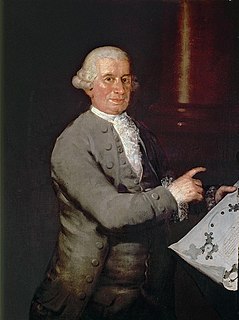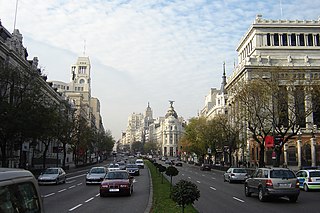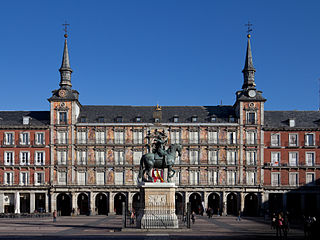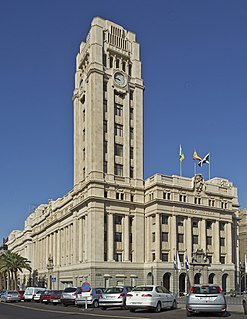
The Buen Retiro Park, Retiro Park or simply El Retiro is one of the largest parks of the city of Madrid, Spain. The park belonged to the Spanish Monarchy until the late 19th century, when it became a public park.

The Royal Palace of Madrid is the official residence of the Spanish royal family at the city of Madrid, although now used only for state ceremonies. The palace has 135,000 m2 (1,450,000 sq ft) of floor space and contains 3,418 rooms. It is the largest functioning royal palace and the largest by floor area in Europe.

The Royal Palace of La Granja de San Ildefonso, known as La Granja, is an early 18th-century palace in the small town of San Ildefonso, located in the hills near Segovia and 80 kilometres (50 mi) north of Madrid, within the Province of Segovia in central Spain.

Centro is the central district of the city of Madrid, Spain. It is approximately 5.23 km2 in size. It has a population of 149,718 people and a population density of 28,587/km2.

El Madrid de los Austrias is a name used for the old centre of Madrid, built during the reign of the Habsburg Dynasty (1516–1700), known in Spain as Casa de Austria. The area is located south of the Calle Mayor, in between the Metro stations Sol and Ópera.

Ventura Rodríguez Tizón was a Spanish architect and artist. Born at Ciempozuelos, Rodríguez was the son of a bricklayer. In 1727, he collaborated with his father in the work at the Royal Palace of Aranjuez.

Buen Retiro Palace in Madrid was a large palace complex designed by the architect Alonso Carbonell and built on the orders of Philip IV of Spain as a secondary residence and place of recreation. It was built in what was then the eastern limits of the city of Madrid. Today, what little remains of its buildings and gardens forms the Retiro Park.

Calle de Alcalá is among the longest streets in Madrid. It starts at the Puerta del Sol and goes on for 11 km, to the northeastern outskirts of the city. Henry David Inglis described it in 1837 as "long, of superb width, and flanked by a splendid range of unequal buildings".

Juan Gómez de Mora (1586–1648) was a Spanish architect.

The Liria Palace is a neoclassical palace in Madrid, Spain. It is the Madrid residence of the Dukes of Alba.

Pedro de Ribera was a Spanish architect of the Baroque period.

The Salón de Reinos or salón grande is a 17th-century building in Madrid, originally a wing of the Buen Retiro Palace. The Salón de Reinos and the Casón del Buen Retiro are the only survivors of the original grand scheme of the palace. Built between 1630 and 1635, the Hall of Realms housed the largest paintings in the royal collection, now all in the Museo del Prado. It is named after its paintings of the coats of arms of the 24 kingdoms which formed the Kingdom of Spain at the time of Philip IV of Spain.

Palacio de Velázquez, or Velázquez Palace is an exhibition hall located in Buen Retiro Park, Madrid, Spain.

The architecture of Madrid has preserved the look and feel of many of its historic neighbourhoods and streets, even though Madrid possesses a modern infrastructure. Its landmarks include the Royal Palace of Madrid, the Royal Theatre with its restored 1850 Opera House, the Buen Retiro Park, the 19th-century National Library building containing some of Spain's historical archives, a large number of national museums, and the Golden Triangle of Art located along the Paseo del Prado and comprising three art museums: Prado Museum, the Reina Sofía Museum, and the Thyssen-Bornemisza Museum, which completes the shortcomings of the other two museums. Cibeles Palace and Fountain have become the monument symbol of the city.
The Palacio del Marqués de Casa Riera was the name for two successive buildings located in the same place, in the Spanish city of Madrid, in the number 64 of the Calle de Alcalá, it was in the widest part of the street.

The Palacio de Xifré is a Madrilenian palace now disappeared that was in the Paseo del Prado, at the corner Calle de Lope de Vega, opposite the Prado Museum. It was one of the best examples of Neo-Mudéjar architecture in Madrid and one of the palaces that the Spanish financial elite of the second half of the 19th century had built along the paseos del Prado, Recoletos and la Castellana.

The Palacio del Marqués de Alcañices, also known as Palacio de Alcañices was a building, now disappeared, which was located in the Calle de Alcalá of Madrid on the land that was other building that occupied Luis Méndez de Haro 6th Marquis del Carpio, a favorite of Philip IV. It belonged to the parish of San Sebastián, and occupied the number 74 of the modern numbering of the street; its other façade bordering the Paseo del Prado. Was named after its owners, the last one José Osorio y Silva, mentor of Alfonso XIII, known as Pepe Osorio and the Grand Duke of Sesto, who also held the title of Marquess of Alcañices, among others.

The Palacio de la Ribera was the summer residence of Philip III in Valladolid. It was built in the 17th century (1602-1605) as part of a process of urban transformation upon the establishment of the Spanish Court in Valladolid between 1601 and 1606. The palace was situated at the Huerta del Rey neighborhood, located across the Parque de las Moreras on the right bank of the Pisuerga river. The palace grounds extended from the Puente Mayor to Ribera de Don Periáñez del Corral and delimited at both sides by the Pisuerga river and the Camino del Monasterio del Prado. The palace was gradually abandoned until it became part of the destroyed cultural heritage of Valladolid in 1761. Some ruins of the building are still preserved.

Palacio Insular de Tenerife is a building in the Spanish city of Santa Cruz de Tenerife, home of the Cabildo de Tenerife. Designed by the architect José Enrique Marrero Regalado, and executed between 1935 and 1940, it is located in the Plaza de España. The building stands out for its tower topped by a clock commissioned in 1950 and is one of the most recognizable symbols of the city of Santa Cruz de Tenerife.

The Jester Calabacillas is a 1626-1632 oil on canvas painting by Diego Velázquez, now in the Cleveland Museum of Art. Its attribution is based on stylistic similarities to other works by the artist - for example, José López-Rey sees similarities in the treatment of the face in this work and that of Bacchus in The Triumph of Bacchus. Its subject is thought to be the jester Juan Calebasse, also painted by the artist in a work now in Madrid and a now-lost work entitled "calebasses in a turban", the latter recorded in 1642 and 1655 inventories of Diego Felipez de Guzmán's collection.




















